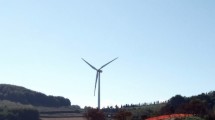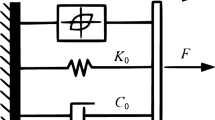Abstract
This paper presents an active controller design to suppress blade edgewise vibrations based on the signal from the wireless sensor. A thorough analysis on concepts for wireless sensors applications for blades is performed. Considering the structural dynamics subjected to gravity and turbulent aerodynamic loadings, a model described dynamics of rotating blades coupled with tower was applicated for control design. Taking the aerodynamic load input in edgewise direction and gravitational load as unknown disturbance input, a stochastic disturbance accommodating control approach is proposed to design a controller with estimate both state and unknown input by a minimum-variance unbiased estimator. The stability analysis proved that the closed loop system is bounded on mean square. In order to verify the performance of the minimum-variance unbiased estimator and the proposed SDAC, numerical simulations using Matlab have been carried out for a 5-MW wind turbine. It is shown the proposed control scheme can further reduce vibration displacement. This study provides a feasibility of future implementation structure control in wind turbine blades.





Similar content being viewed by others
References
Wang, L., Liu, X., & Kolios, A. (2016). State of the art in the aeroelasticity of wind turbine blades: Aeroelastic modelling. Renewable and Sustainable Energy Reviews, 64, 195–210.
Rahman, M., Zhi, C. O., Wen, T. C., et al. (2015). Performance enhancement of wind turbine systems with vibration control: A review. Renewable and Sustainable Energy Reviews, 51, 43–54.
Staino, A., Basu, B., & Nielsen, S. R. K. (2012). Actuator control of edgewise vibrations in wind turbine blades. Journal of Sound and Vibration, 331, 1233–1256.
Staino, A., & Basu, B. (2013). Dynamics and control of vibrations in wind turbines with variable rotor speed. Engineering Structures, 56, 58–67.
Song, G., Li, H., Gajic, B., et al. (2013). Wind turbine blade health monitoring with piezoceramic-based wireless sensor network. International Journal of Smart & Nano Materials, 4(3), 150–166.
Sampath, U., Kim, H., Kim, D. G., et al. (2015). In-situ cure monitoring of wind turbine blades by using fiber Bragg grating sensors and Fresnel reflection measurement. Sensors, 15(8), 18229–18238.
Schubel, P. J., Crossley, R. J., Boateng, E. K. G., et al. (2013). Review of structural health and cure monitoring techniques for large wind turbine blades. Renewable Energy, 51(2), 113–123.
May, A., Mcmillan, D., & Thöns, S. (2015). Economic analysis of condition monitoring systems for offshore wind turbine sub-systems. Renewable Power Generation Iet, 9(8), 900–907.
Civelek, Z., Lüy, M., Çam, E., et al. (2017). A new fuzzy logic proportional controller approach applied to individual pitch angle for wind turbine load mitigation. Renewable Energy, 111, 708–717.
Giri, P. (2016). Development of wireless laser blade deflection monitoring system for mobile wind turbine management host. Journal of Intelligent Material Systems and Structures, 25(11), 1384–1397.
Chen, W. H., Yang, J., Guo, L., et al. (2016). Disturbance observer based control and related methods: An overview. IEEE Transactions on Industrial Electronics, 63, 1083–1095.
Gillijns, S., & De Moor, B. (2007). Unbiased minimum variance input and state estimation for linear discrete time systems. Automatica, 43, 111–116.
Fang, H., & Callafon, R. A. D. (2012). On the asymptotic stability of minimum-variance unbiased input and state estimation. Automatica, 48, 3183–3186.
Xie, L., & Khargonekar, P. P. (2012). Lyapunov-based adaptive state estimation for a class of nonlinear stochastic systems. Automatica, 48, 1423–1431.
Benowitz, B. A., & Deodatis, G. (2015). Simulation of wind velocities on long span structures: A novel stochastic wave based model. Journal of Wind Engineering and Industrial Aerodynamics, 2015(147), 154–163.
Author information
Authors and Affiliations
Corresponding author
Rights and permissions
About this article
Cite this article
Cong, C. Stochastic Vibrations Control of Wind Turbine Blades Based on Wireless Sensor. Wireless Pers Commun 102, 3503–3515 (2018). https://doi.org/10.1007/s11277-018-5387-0
Published:
Issue Date:
DOI: https://doi.org/10.1007/s11277-018-5387-0




